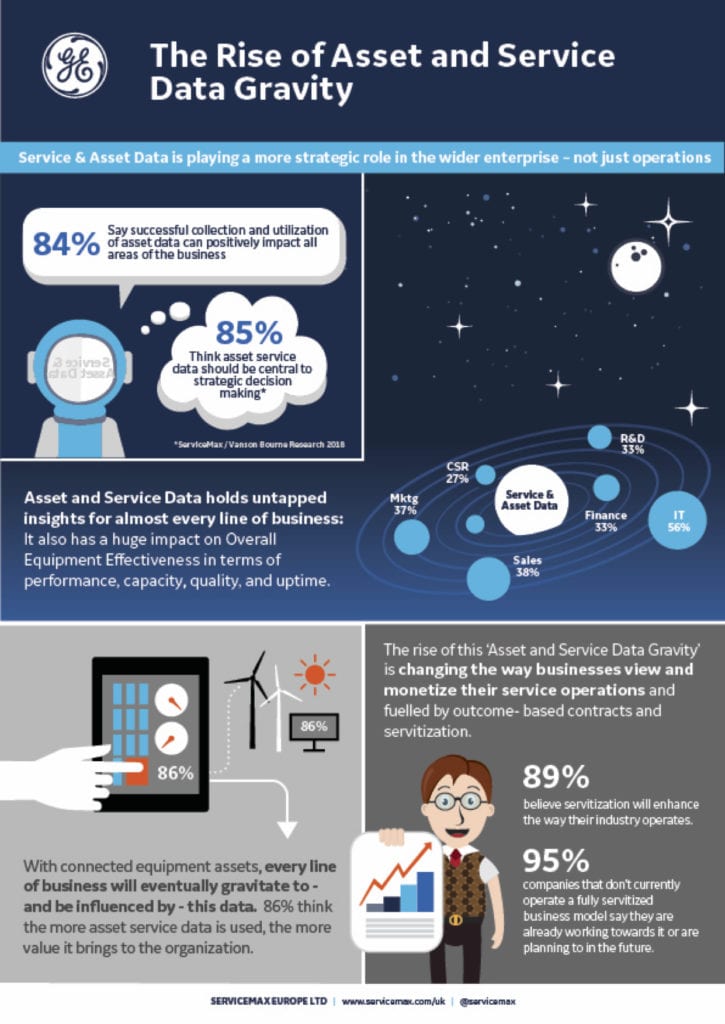What if I told you your company’s asset and service data could give you a double-digit revenue boost? In a world dominated by disruption and change, companies are finding innovative ways of achieving growth. Part of that innovation is looking at smarter ways of monetizing equipment assets. Automated asset and service data is becoming increasingly valuable due to its breadth and depth of product and customer information, which holds all sorts of insights for companies that extend far beyond their service operations. And that value is having a gravitational pull on other parts of the business.
In fact, asset and service data hold untapped intelligence for almost every line of business — from sales, R&D, IT, finance, marketing and Corporate Social Responsibility, and it also has a huge impact on overall equipment effectiveness in terms of performance, capacity, quality, and uptime. The rise of this ‘asset and service data gravity’ is putting a sharper business lens on enterprise performance, showing both the good and the bad.
According to a new global research study by Vanson Bourne, “The Rise of Asset and Service Data Gravity,” for every $1 spent on successful service data collection and usage, companies expect a return of $4.44 — approaching five times the initial outlay. And companies say that aggregating and analyzing asset and service data will give them a 14 percent increase in revenue. Not a bad return. But the study also revealed some worrying gaps around revenue and contract leakage.
Of the estimated 187,470 field service work orders conducted on average each year, 15,635 (8.34 percent) of them remain unaccounted for within organizations. That’s millions being lost in revenue on a regular basis — unacceptable by any standard.
Field service engineers, dispatchers and managers rely on and collect valuable data direct from source and ensure its accuracy, whether that’s product status and performance, contracts, contacts, location or account details. It’s valuable information which needs to be digitally captured and recorded.
With the advent of predictive analytics and condition-based maintenance, this data, which can be curated and fed into an organization’s data system, has the potential to provide accurate intelligence across the entire organization. And it can enhance other data sources such as CRM, ERP, parts, logistics and supply chain, HR, compliance and even data sources such as traffic and weather forecasting. Essentially, field service and asset data give all other data relevance and accuracy.
While historically the service department has been a consumer of sources such as CRM data, it is now starting to feed valuable asset data back into the system. It fits with the overall shift we have seen in recent years with service moving from cost centre to profit centre. Its data is now part of that development.
With the adoption of field service technology, a field service engineer, as part of their work order debrief, can also contribute significant amount of hands on insight and context into the health and well-being of a piece of equipment. Capturing this insight, particularly on older assets and equipment not yet IIoT-enabled, is a critical priority for the transfer of structured diagnostic assessment, knowledge, resolution experience.
And for those organizations who are already embracing IIoT, the asset and service data from connected equipment, machines, devices, field service reports, and digital twins is now actionable. Because it is both rich and accurate, other data and departments are starting to gravitate towards it. We are starting to see this ‘Asset Data Gravity’ effect re-shaping the way businesses are making both operational and strategic decisions for the better.
You can find out more about the changing role of asset and service data by clicking here.



Share this: